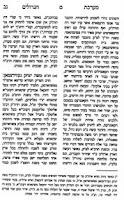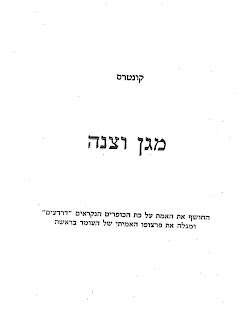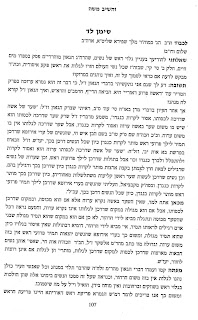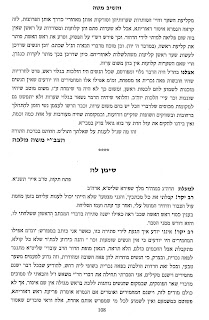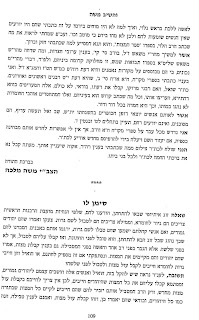In response to Professor Menachem Kellner's thoughtful post at the Seforim blog regarding Rabbi Aryeh Leibowitz's recent article in the latest issue of Tradition and subsequent response at the Seforim blog, frequent contributor to the Seforim blog, Rabbi Chaim Rapoport of London, presents his latest offering below:
שבט לוי" בספר 'משנה תורה' להרמב"ם[1] ובזמן הזה"
תגובות למאמר החכם פרופסר מנחם קלנר
הרב חיים רפופורט
לונדון אנגלי'
הקדמה
בספר 'משנה תורה', בסוף הלכות שמיטה ויובל (פי"ג הי"ב והי"ג) ובסיום 'ספר זרעים', כתב הרמב"ם[2]: ולמה לא זכה[3] לוי בנחלת ארץ ישראל ובביזתה עם אחיו, מפני שהובדל לעבוד את ה' לשרתו ולהורות דרכיו הישרים ומשפטיו הצדיקים לרבים[4], שנאמר (פ' ברכה לג, יו"ד) 'יורו משפטיך ליעקב ותורתך לישראל'.[5] לפיכך הובדלו מדרכי העולם; לא עורכין מלחמה כשאר ישראל, ולא נוחלין, ולא זוכין לעצמן בכח גופן[6], אלא הם חיל השם שנאמר (שם, יא) 'ברך ה' חילו', והוא ברוך הוא זוכה להם שנאמר (פ' קרח יח, כ) 'אני חלקך ונחלתך'. ולא שבט לוי בלבד אלא כל איש ואיש מכל באי העולם אשר נדבה רוחו אותו והבינו מדעו[7] להבדל לעמוד לפני ה' לשרתו ולעובדו לדעה[8] את ה' והלך ישר כמו שעשהו האלקים ופרק מעל צוארו עול החשבונות הרבים אשר בקשו בני האדם[9] הרי זה נתקדש קדש קדשים[10] ויהי' ה' חלקו ונחלתו לעולם ולעולמי עולמים ויזכה לו בעולם הזה[11] דבר המספיק לו[12] כמו שזכה לכהנים וללוים[13], הרי דוד עליו השלום[14] אומר (תהלים טז, ה), 'ה' מנת חלקי וכוסי אתה תומיך גורלי'. עד כאן לשון הרמב"ם.
והנה זה עתה מצאתי ב'אתר הספרים', המיוחד למאמרי חכמים וסופרים, שקלא וטריא בביאור דברי הנשר בידו, זה אומר בכה וזה מראה באצבעו לעומתו.
ואמרתי אף אני אענה את חלקי שהניחו לי, פרי עמלי בביאור דברי המיימוני, ואינני אומר קבלו דעתי, רק ירא הקהל וישפוט: הדין עם מי.
"כל איש ואיש מכל באי העולם"
א) במאמרו שנדפס זה עתה ב'אתר הספרים', כתב ידידי החכם פרופ. מנחם קלנר, שכוונת הרמב"ם בביטויו "כל איש ואיש מכל באי העולם" היא ליהודים וגויי הארצות כאחד.
והנני בזה, לכל לראש, לציין לתנא דמסייע לי' בזה:
באגרת כ"ק אדמו"ר מליובאוויטש זי"ע מיום ג' תמוז ה'תשכ"ד[15] עמד ג"כ על דברי הרמב"ם אלו, ועל המילים "כל באי העולם" כתב בזה הלשון: "כולל גם אומות העולם - ראה ראש השנה פ"א מ"ב ['בראש השנה כל באי העולם עוברין לפניו כבני מרון שנאמר (תהלים לג, טו) היוצר יחד לבם המבין אל כל מעשיהם'] . . . - כי חסידי אומות העולם יש להם חלק לעולם הבא (רמב"ם הל' מלכים סוף פ"ח[16])". עכ"ל.[17]
גם מבואר מדבריו, דס"ל דזה שגם גוי מ'אומות העולם' יכול להגיע לדרגת 'קדש קדשים', אין זה בגלל יכולתו להתגייר[18] ולהתעלות למדריגות גבוהות ככל ישראל ('ככם כגר'), כי אם שגם בהיותו גוי יכול להתקדש עד כדי כך ש"יהי' ה' חלקו ונחלתו לעולם ולעולמי עולמים", וכהא דקיי"ל ש"חסידי אומות העולם יש להם חלק לעולם הבא"[19].
ובמקום אחר[20] ציין אדמו"ר לכמה מקומות בספר 'משנה תורה' שבהם השתמש הרמב"ם בביטוי "באי עולם" או "באי העולם", והכוונה נראית ברורה, שר"ל 'כל בני אדם', ואלו הם:
(א) הל' תשובה פ"ג ה"ג ["בכל שנה ושנה שוקלין עונות כל אחד ואחד מבאי העולם עם זכיותיו ביום טוב של ראש השנה]; (ב) שם פ"ו ה"ג ["ולמה הי' שולח לו ביד משה ואומר שלח ועשה תשובה וכבר אמר לו הקב"ה אין אתה משלח כו' כדי להודיע לבאי העולם שבזמן שמונע הקב"ה התשובה לחוטא אינו יכול לשוב אלא ימות ברשעו"]; (ג) הל' ספר תורה פ"י הי"א "שהוא העד הנאמן לכל באי עולם"]; (ד) הל' סנהדרין פי"ב ה"ג ["הרי כל באי עולם בצורת אדם הראשון הם נבראים"]; (ה) הל' מלכים פ"ח הי"א ["וכן צוה משה רבינו מפי הגבורה לכוף את כל באי העולם לקבל מצות שנצטוו בני נח"].
ועליהם יש להוסיף: (ו) נוסח התפלה הנמצא ב'סדר תפלות לכל השנה'[21] הנקבע בספר 'משנה תורה' להרמב"ם בסוף ספר 'אהבה': "קבץ קויך מארבע כנפות הארץ יכירו וידעו כל באי עולם כי אתה הוא האלקים לבדך לכל ממלכות הארץ".
ויש להעיר גם ממ"ש הרמב"ם ב'פירוש המשנה' עמ"ס ביכורים. במשנה שם (פ"א מ"ד) שנינו: "אלו מביאין ולא קורין, הגר מביא ואינו קורא, שאינו יכול לומר 'אשר נשבע ה' לאבותינו'[22]". ובפירוש המשנה שם כתב הרמב"ם, דלהלכה לא קיי"ל כמשנה זו אלא ש"מביא הגר עצמו בכורים וקורא, וסמכוהו למה שאמר ה' לאברהם (פ' לך יז, ה) 'כי אב המון גוים נתתיך', אמרו[23] לשעבר הייתה אב לארם עכשיו אב לכל העולם כולו, ולפיכך אפשר לכל גר לומר 'אשר נשבע ה' לאבותינו', מפני שאברהם אב לכל באי העולם לפי שלימדם האמונה והדת", וגם בדבריו אלו הכוונה היא לגוים[24], וכמ"ש הרמב"ם בהל' ע"ז (פ"א ה"ג) על אברהם אבינו, ד"כיון שהכיר וידע (אברהם את בוראו) . . . התחיל לעמוד ולקרוא בקול גדול לכל העולם ולהודיעם שיש שם אלו-ה אחד לכל העולם ולו ראוי לעבוד, והי' מהלך וקורא ומקבץ העם מעיר לעיר ומממלכה לממלכה . . . שנאמר (פ' וירא כא, לג), ויקרא שם בשם ה' א-ל עולם".[25]
ואם ישאל השואל: היאך שייך שמי שאין לו קדושת ישראל יוכל "לעמוד לפני ה' לשרתו ולעובדו לדעה את ה'", אף אתה אמור לו: עבודת ה' ושירותו שייכות גם באומות העולם, וכמבואר ממ"ש הרמב"ם בהל' ע"ז שם, ש"כיון שהכיר [אברהם אבינו] וידע (את בוראו) התחיל . . . להודיע לעם שאין ראוי לעבוד אלא לאלו-ה העולם כו' כדי שיכירוהו כל הברואים הבאים", ע"ש.
וגם לדורות נצטווינו, (כמ"ש הרמב"ם[26]), "שנדרוש ונקרא האנשים כולם לעבודתו יתעלה ולהאמין בו . . . כי כשתאהב אדם תשים לבך עליו ותשבחהו ותבקש האנשים לאהוב אותו . . . ולשון סיפרי[27] 'ואהבת את ה' וגו', אהבהו על הבריות כאברהם אביך, שנאמר (פ' לך יב, ה) ואת הנפש אשר עשו בחרן', ר"ל, כמו שאברהם בעבור שהי' אוהב השם כמו שהעיד הכתוב (ישעי' מא, ח) 'אברהם אוהבי' שהי' גם כן לגודל השגתו דרש האנשים אל האמונה מחוזק אהבתו, כן אתה אהוב אותו עד שתדרוש האנשים אליו".
[וכן יהי' בימות המלך המשיח ש"ילמד כל העם ויורה אותם דרך ה' ויבואו כל הגוים לשומעו, שנאמר (ישעי' ב, ב[28]), 'והי' באחרית הימים נכון יהי' הר בית ה' בראש ההרים[29] ונשא מגבעות ונהרו אליו כל הגוים'," ויתקן "את העולם כולו לעבוד את ה' ביחד, שנאמר (צפני' ג, ט) כי אז אהפוך אל עמים שפה ברורה לקרוא כולם בשם ה', ולעבדו שכם אחד"[30]].
ע"פ כל הנ"ל מבואר שהרמב"ם בסוף הל' שמיטה ויובל מדבר על כל מי ש"נדבה רוחו אותו והבינו מדעו להבדל לעמוד לפני ה' לשרתו ולעובדו", וכל איש ואיש מבאי העולם – אפילו גוי – יכול להתקדש 'קדש קדשים'[31].
"לְבַד רְאֵה זֶה מָצָאתִי אֲשֶׁר עָשָׂה הָאֱלֹקִים אֶת הָאָדָם יָשָׁר וְהֵמָּה בִקְשׁוּ חִשְּׁבֹנוֹת רַבִּים" (קהלת ז, כט).
ב) הרמב"ם רקם בתוך דבריו את הכתוב בספר קהלת וכתב: "כל איש ואיש מכל באי העולם אשר נדבה רוחו אותו כו' והלך ישר כמו שעשהו האלקים ופרק מעל צוארו עול החשבונות הרבים אשר בקשו בני האדם".
פרופסר קלנר נסתבך קצת בדברי הרמב"ם אלו, והעלה שאולי כוונתו לחלוק על מ"ש המקובלים בענין חטא עה"ד.
אבל באמת נראה שכוונת הרמב"ם פשוטה, ודבריו עשירים במקום אחר - בספרו 'מורה נבוכים' חלק שלישי פרק יב. ב'מורה' שם הגדיר וביאר שלשה מיני 'רעה' שנפגעים בהם בני אדם בעולם הזה, ו"המין השלישי מן הרעות הוא מה שימצא כל אחד מבני אדם מפעולתו בעצמו, וזהו הרוב . . . ומרעות זה המין יצעקו בני אדם כולם . . . ועל זה המין מן הרעות אמר שלמה (משלי יט, ג) אולת אדם תסלף דרכו וגו', וכבר ביאר גם כן בזה המין מן הרעות שהוא פועל האדם בעצמו, והוא אמרו 'לבד ראה זה מצאתי אשר עשה האלקים את האדם ישר והמה בקשו חשבונות רבים', והחשבונות ההם הם אשר הביאו עליו אלו הרעות, ועל זה המין נאמר (איוב ה, ו) כי לא יצא מעפר און ומאדמה לא יצמח עמל, ואח"כ ביאר מיד שהאדם הוא אשר ימציא זה המין מן הרע, ואמר (איוב שם, ז) כי אדם לעמל יולד וגו', וזה המין הוא הנמשך אחר המדות המגונות כולם, ר"ל רוב התאוה במאכל ובמשתה ובמשגל, ולקיחתם ביתרון כמות, או בהפסד סדר, או בהפסד איכות המזונות, ויהי' סיבה לכל החליים והמכות הגשמיות והנפשיות", ע"ש בארוכה.
הרי מבואר שכוונת הרמב"ם במ"ש בהל' שמיטה ויובל "כל איש ואיש . . . אשר נדבה רוחו אותו . . . והלך ישר כמו שעשהו האלקים ופרק מעל צוארו עול החשבונות הרבים אשר בקשו בני האדם", פירושו שלא הביא על עצמו רעה על ידי המשכו אחרי תאוות עולם הזה, וע"כ לא סבל מ"החשבונות ההם". כיון שהלך אך ורק בדרך הישר, לא נגרע מאיכות הטוב אשר בו עשה האלקים את האדם.
"כל איש ואיש . . . אשר נדבה רוחו אותו . . . להבדל"
והנה יש לעיין במה שכתב הרמב"ם בנוגע ל"כל איש ואיש מכל באי העולם אשר נדבה רוחו אותו", דיש לפרש כוונתו בשני אופנים:
(א) שמדבר מכל איש ואיש אשר, כמו שבט לוי ממש, אין לו עסק בנחלת שדה וכרם ואינו זוכה לפרנסתו בכח גופו, כי הבדיל א"ע מכל התעסקות בדרכי העולם וכל ימיו ושנותיו מוקדשים אך ורק לעבודת ה' ולהורות דרכיו לרבים. 32
וממקומו אתה למד, שהרי הרמב"ם כתב את דבריו אודות "כל איש ואיש אשר הבינו מדעו" בהמשך ישר לדבריו מענין התפקידים שהוטלו על שבט הלוי ו'הבדלתם' לעבוד את ה'. וע"כ נראה שכיוון לאותו סוג וגדר של הבדלה המיועדת לשבט הלוי, דהיינו שדיבר כלפי המורמים מעם בכל דור ודור שהבדילו את עצמם להתמסר אך ורק להתפקידים המיועדים לשבט לוי. ומה הם התפקידים המיוחדים לשבט הלוי? גם זה מפורש ב'משנה תורה' על אתר: (א) "לעבוד את ה' ולשרתו"[33]; (ב) "להורות דרכיו הישרים ומשפטיו הצדיקים לרבים".
[ויש להוסיף ולהבהיר, שאין בזה סתירה להמבואר לעיל שהרמב"ם הרחיב את המעגל לכלול בתוכו גם אומות העולם, כי "להורות דרכיו הישרים ומשפטיו הצדיקים לרבים", שייך, במדה מסויימת, גם באומות העולם, שהרי כבר השריש הרמב"ם ב'ספר המדע' (הל' דעות פ"א ה"ה) מה הם "הדרכים הטובים והישרים" ועל זה הביא (שם ה"ז) הכתוב (פ' וירא יח, יט) "כי ידעתיו למען אשר יצוה את בניו ואת ביתו אחריו לעשות צדקה", והרי כתב הרמב"ם (בהל' ע"ז שם) שה"אלפים ורבבות" של בני נח (=גוים) שהשפיע עליהם אברהם אבינו עד שהחזירם לדרך האמת34 הם "הם אנשי בית אברהם".35
(ב) שאין הרמב"ם מייחד את דיבורו בהלכה זו לאלו שהובדלו מדרכי העולם לבדם [אשר בהכרח אין סדר זה נחלת הכלל ושייך רק ליחידי סגולה], אלא כוונתו שכל איש ואיש אפילו אלו שאינם נבדלים מדרכי העולם, יכולים להתקדש 'קדש קדשים' על ידי ההתמסרות לחיים מקודשים, דהיינו חיים המוקדשים – כל כולם – לעבודת ה'. ואע"פ שעוסק במשא ומתן ונוהג במנהג דרך ארץ הרי כבר כתב הרמב"ם בהל' דעות (פ"ג ה"ג) שאפשר להיות "עובד את ה' תמיד, אפילו בשעה שנושא ונותן וכו' מפני שמחשבתו בכל כדי שימצא צרכיו עד שיהי' גופו שלם לעבוד את ה'."36]
לפי האופן השני תורף דברי הרמב"ם כך הם: כל אחד ואחד ממש יכול להתדמות ללויים במדה מסויימת. והיינו, דכמו שהלויים היו מיוחדים לעבוד את ה' תמיד, כמו כן כל איש ואיש - אפילו אם אינו משבט לוי ועל כן הוא עוסק בדרכי העולם - יכול להיות עובד ה' תמיד (וכנ"ל מהל' דעות); וכמו ששבטו של לוי זכו למתנות מיוחדות מאת ה' כדי לעזור להם במשימתם המיוחדת, כך יזכה גם הוא לסייעתא דשמיא והקב"ה יספיק לו את צרכיו בזה ובבא.
ואם כי, בדרך כלל, הבינו גדולי הדורות את דברי הרמב"ם באופן הראשון, נראה שמקום הניחו לנו לפרשו גם באופן השני.
ועל פי אופן זה השני יובן מה שינה הרמב"ם בסגנונו: (א) שבהלכה יב, בתיאור שבט לוי, כתב "שהובדל לעבוד את ה' לשרתו ולהורות דרכיו הישרים ומשפטיו הצדיקים לרבים", ואילו בהי"ג, בתיאור נדיבי הרוח מכל באי עולם, כתב "להבדל לעמוד לפני ה' לשרתו ולעובדו לדעה את ה'," ואילו "להורות דרכיו כו' לרבים" לא קתני; (ב) שבהלכה יב, בתיאור שבט לוי, כתב ש"הובדלו מדרכי העולם" וביאר כוונתו ש"לא עורכין מלחמה כו' ולא נוחלין ולא זוכין לעצמן בכח גופן", משא"כ בהי"ג בתיאור 'נדיב הרוח', לא כתב שהובדל מדרכי העולם, ובמקום זה הוסיף שני דברים שהם מתפקידי כל אדם הראוי לשמו, ואלו הם: "לדעה את ה'," – וכמ"ש הרמב"ם בהל' דעות ש"צריך האדם שיכוון לבו וכל מעשיו כולם לידע את השם ברוך הוא בלבד"; ש"הלך ישר כמו שעשהו האלקים ופרק מעל צוארו עול החשבונות הרבים אשר בקשו בני האדם", שכוונתו בזה (כמשנ"ת לעיל ס"ב) שלא נמשך המותרות וכו' המקלקלים את האדם, אשר גם זה הוא הדרך הישר שיבור לו כל אדם וכמ"ש הרמב"ם בהל' דעות.
מחלוקת חכמי המדע: פרופסר קלנר לעומת ר' ארי' לייבאוויץ
ג) והנה במאמרו הנ"ל יצא פרופ. קלנר בסופה ובסערה נגד אלו שהראו מקום לדברי הרמב"ם הנ"ל (הל' שמיטה ויובל פי"ג הי"ג) בקשר לאלו שתורתם אומנתם, [או להורות שיש מקום לחכמי התורה להתלות על נדבות הציבור או להורות על הצורך שיש לתלמידי חכמים להסתפק במועט[37], וכתב דכיון שהרמב"ם מיירי (גם) מגוים, אין לדבריו אלו שום זיק וקשר לאלו שמתמסרים לגמרי ללמוד התורה (והוראת התורה) באופן ד'תורתם אומנתם'.
ואילו הרב לייבאוויץ טען דמה בכך שלשון הרמב"ם 'כל באי העולם' כולל גם גוים, וכי בכלל שהרמב"ם סובר שגם חסידי אומות העולם יכולים להבדל ולהתקדש כשבט לוי, אי אפשר לישראל, מזרע אברהם יצחק ויעקב, להתעלות גם הוא עד כדי כך? יציבא בארעא וגיורא בשמי שמיא!
אמנם נראה שפרופסר קלנר קיצר במקום שהי' לו להאריך. כנראה הוא הבין את דברי הרמב"ם כאופן השני הנ"ל, ד"כל איש ואיש מכל באי העולם" לא מיירי באלו (יהודים או גוים) המניחים חיי שעה ועוסקים אך ורק בחיי עולם אלא מכל איש ואיש, כולל אלו שיש להם נחלת שדה וכרם ונהנים מיגיע כפיהם. ועל כן טען שאין ללמוד מדברי הרמב"ם שום דבר בקשר להנהגת חכמי ישראל או (להבדיל) חכמי אומות העולם שהובדלו מדרכי העולם!
אבל ר' ארי' לייבאוויץ הבין דברי הרמב"ם, כמו שהבינו רוב מפרשיו מקדמת דנא, כאופן הראשון הנ"ל, וע"כ ראה בדברי הרמב"ם הדרכה מעשית להתלמידים והחכמים הנבדלים מדרכי העולם.
והבוחר יבחר.
ה' מנת חלקי וכוסי אתה תומיך גורלי : הא כיצד
ג) והנה, לפי שיטתו הנ"ל, יצא החכם קלנר לחלוק על אלו שמצאו סמוכין בדברי הרמב"ם בסוף הל' שמיטה ויובל הנ"ל, להחזקת בני תורה ורבנים, ישיבות וכוללים וכל הנשענים על תמכין דאורייתא, כמעשה יששכר וזבולון וכשמעון אחי עזרי'[38], ודכוותייהו טובא.[39]
פרופ. קלנר טוען כי אין דברי הרמב"ם שייכים לענין זה כלל, ולא בא הרמב"ם כי אם לומר שהקב"ה הוא הוא ה'תומך שבט' לוי ודכוותי' כל איש ואיש מכל באי עולם, יהיו מי שיהיו, המקדישים את עצמם לגמרי לעבודת ה' – יהי' באיזה אופן שיהי'. [40]
וגם בזה יש מקום לבע"ד לחלוק על דברי פרופ. קלנר.
הנה אמת נכון הדבר, שבדברי הרמב"ם באותה הלכה [המתחלת בתיבות "ולא שבט לוי בלבד"] בלבדה, אין שום הוכחה למעשה תמכין דאורייתא ואופן החזקת תלמידי חכמים ומורי הוראה בימיו ובימינו, כי: (א) לפי האופן השני הנ"ל (שכנראה נקט בו פרופ. קלנר) אין הרמב"ם מדבר בהלכה זו מאלו שתורתם אומנתם כלל, וכמשנ"ת; (ב) גם לאופן הראשון הנ"ל, יש לפרש דמ"ש הרמב"ם "ויזכה לו בעולם הזה דבר המספיק לו כמו שזכה לכהנים וללוים", פירושו שהוא יתברך, בכבודו ובעצמו, ימציא עבורם "בעולם הזה דבר המספיק לו" למלאות צרכיו. [41]
מכל מקום, נראה שעדיין יש מקום בראש לטעון ולומר, שהנהוג בימינו (ועד"ז בדורות קודמים) שתלמידי חכמים ורבנים מוסמכים מקבלים מחייתם מן הציבור, יש לה מעין מקור בדברי הרמב"ם בהלכה זו בצירוף דברי הרמב"ם בהלכה שלפני' ובהלכות אחרות.
הסברת הדברים: בדבר שבט לוי קבע הרמב"ם שבגלל "שהובדל לעבוד את ה' לשרתו . . . לפיכך הובדלו מדרכי העולם; לא עורכין מלחמה כשאר ישראל, ולא נוחלין, ולא זוכין לעצמן בכח גופן".
וכאן הבן שואל: התינח שאין בני שבט לוי עורכין מלחמה, הרי אחיהם, בני שאר השבטים, נלחמים בעדיהם. אבל אם אינם נוחלין ואינם עובדים – מהיכן שבט זה חי?
והנה בנוגע לנחלה כבר כתב הרמב"ם בתחלת הפרק ש"שבט לוי אע"פ שאין להם חלק בארץ כבר נצטוו ישראל ליתן להם ערים לשבת ומגרשיהם", אבל עדיין יש מקום לתמוה, דהתינח בתים לשבת בהם, אבל כיון שאין להם נחלת שדה וכרם, מנין יגיע להם (בדרך הטבע) לחם לאכול ובגד ללבוש?
ישוב תמיה זו אינו צריך לפנים: הרי הוא מפורש בתורה ושנוי ב'משנה תורה' להרמב"ם ומשולש ומבואר בספרו 'מורה נבוכים'.
כתוב בתורה:
(א) בפרשת ראה יב, יא-יב: וְהָיָה הַמָּקוֹם אֲשֶׁר יִבְחַר ה' אֱלֹקֵיכֶם בּוֹ לְשַׁכֵּן שְׁמוֹ שָׁם שָׁמָּה תָבִיאוּ אֵת כָּל אֲשֶׁר אָנֹכִי מְצַוֶּה אֶתְכֶם עוֹלֹתֵיכֶם וְזִבְחֵיכֶם מַעְשְׂרֹתֵיכֶם וּתְרֻמַת יֶדְכֶם וְכֹל מִבְחַר נִדְרֵיכֶם אֲשֶׁר תִּדְּרוּ לַה'. וּשְׂמַחְתֶּם לִפְנֵי ה' אֱלֹקֵיכֶם אַתֶּם וּבְנֵיכֶם וּבְנֹתֵיכֶם וְעַבְדֵיכֶם וְאַמְהֹתֵיכֶם וְהַלֵּוִי אֲשֶׁר בְּשַׁעֲרֵיכֶם, כִּי אֵין לוֹ חֵלֶק וְנַחֲלָה אִתְּכֶם";
(ב) שם יד, כו-כז: "וְנָתַתָּה הַכֶּסֶף בְּכֹל אֲשֶׁר תְּאַוֶּה נַפְשְׁךָ בַּבָּקָר וּבַצֹּאן וּבַיַּיִן וּבַשֵּׁכָר וּבְכֹל אֲשֶׁר תִּשְׁאָלְךָ נַפְשֶׁךָ וְאָכַלְתָּ שָּׁם לִפְנֵי ה' אֱלֹקֶיךָ וְשָׂמַחְתָּ אַתָּה וּבֵיתֶךָ. וְהַלֵּוִי אֲשֶׁר בִּשְׁעָרֶיךָ לֹא תַעַזְבֶנּוּ כִּי אֵין לוֹ חֵלֶק וְנַחֲלָה עִמָּךְ";
(ג) שם יד, כט: "וּבָא הַלֵּוִי כִּי אֵין לוֹ חֵלֶק וְנַחֲלָה עִמָּךְ וְהַגֵּר וְהַיָּתוֹם וְהָאַלְמָנָה אֲשֶׁר בִּשְׁעָרֶיךָ וְאָכְלוּ וְשָׂבֵעוּ לְמַעַן יְבָרֶכְךָ ה' אֱלֹקֶיךָ בְּכָל מַעֲשֵׂה יָדְךָ אֲשֶׁר תַּעֲשֶׂה"
שנוי ב'משנה תורה' להרמב"ם:
(א) בנוגע לשבט לוי, ברמב"ם הל' חגיגה פ"ב הי"ד: "חייב לשמח העניים והאומללים שנאמר (פרשת ראה טז, יא) 'והלוי והגר והיתום והאלמנה', מאכיל הכל ומשקן כפי עשרו. ומי שאכל זבחיו ולא שמח אלו עמו, עליו נאמר (הושע ט, ד) 'זבחיהם כלחם אונים להם, כל אוכליו יטמאו, כי לחמם לנפשם', ומצוה בלוי יותר מן הכל לפי שאין לו לא חלק ולא נחלה ואין לו מתנות בבשר, לפיכך צריך לזמן לויים על שולחנו ולשמחם, או יתן להם מתנות בשר עם מעשר שלהם כדי שימצאו בו צרכיהם, וכל העוזב את הלוי מלשמחו ושוהה ממנו מעשרותיו ברגלים, עובר בלא תעשה, שנאמר (פרשת ראה יב, יט), 'השמר לך פן תעזוב את הלוי'."[42]
(ב) בנוגע לכהנים, ברמב"ם הל' ביכורים פ"י ה"ה: "כיון שזיכה לו הקב"ה בתרומות שהן לחמו ויינו, וזיכה לו במתנות בהמה וקדשי מקדש שהבשר שלו, זיכה לו בראשית הגז ללבושו, ובגזל הגר והחרמים ושדה אחוזה ופדיון בכורות להוצאותיו ושאר צרכיו, שהרי אין לו חלק בנחלה ובבזה".
ומשולש במורה נבוכים:
ב'מורה נבוכים' חלק שלישי (הנ"ל) עמד הרמב"ם ג"כ על תפקידו המיוחד של שבט לוי וטעמי מצוות מתנות כהונה ולוי', וכתב (בסגנון המקביל למ"ש בהל' שמיטה ויובל), וזה לשונו: "מתנות עניים ענינם מבואר גם כן, ענין התרומה והמעשר כבר ביאר סיבתם, 'כי אין לו חלק ונחלה עמך', וכבר ידעת סיבת זה כדי שיהי' זה השבט כולו מיוחד לעבודת השם ולידיעת התורה, ולא יתעסק לא בחרישה ולא בזריעה רק יהי' להשם לבד, כמ"ש יורו משפטיך ליעקב ותורתך לישראל ישימו קטורה וגו', ותמצא דברי התורה במקומות רבים הלוי הגר והיתום והאלמנה, ימנה אותו תמיד בכלל העניים בעבור שאין לו קנין[43]".
[וע"פ כל הנ"ל נראה דמ"ש הרמב"ם בהל' שמיטה ויובל שם, שהכהנים והלויים שהובדלו מדרכי העולם "הם חיל השם . . . והוא ברוך הוא זוכה להם", פירושו שהקב"ה מזכה להם מתנות כהונה ולוי' כדי שעי"ז יהי' להם מזון ולבוש, [44] ולשון הרמב"ם "והוא ברוך הוא זוכה להם" הוא ע"ד מ"ש בהל' ביכורים שם: "כיון שזיכה לו הקב"ה כו' לחמו ויינו, וזיכה לו במתנות . . . זיכה לו בראשית הגז"].
הוה אומר: לפי דעת הרמב"ם קבעה התורה שהכהנים הלויים אינם מתעסקים בחרישה וזריעה ושאר שבילי פרנסה וכלכלה, וע"כ יהיו 'עניים' ותלויים באחיהם בני שאר השבטים שיפרנסו ויזונו אותם משלהם בתרומות ומעשרות ועוד מתנות עניים.
ועל פי כל הנ"ל הי' נראה לכאורה, שההנהגה (השכיחה גם בימינו) שהמובדלים לעבוד את ה' בלבד יסמכו על הציבור לצורך פרנסתם ופרנסת בני ביתם, אף שאין מקור ברור לזה מדברי הרמב"ם, ה"ה מושרשת ומעוגנת היטב בהיסודות ההגיוניים שהציק הרמב"ם בקשר לשבט לוי.
ואכן מצינו שרבים מגדולי ישראל בימיהם ובימינו ראו ב'שבט לוי' שורש לההשקפה המבססת את תמיכת חכמי התורה בכספי ציבור.
הרי שלש דוגמאות מני הרבה:
(1) בשו"ת 'חתם סופר' אורח חיים סימן רח כתב, וז"ל בא"ד: "כי כשישראל יושבים על אדמתם מלאים כל טוב, כל אחד פונה לכרמו ולזיתו, הבדיל הקב"ה שבט הנבחר והמציא להם פרנסתם בריוח בלי שום עבודה, חרישה וקצירה, וכל שבט אין לו חלק אלא אחד משנים עשר מה שמוציא האדמה דגן תירוש ויצהר, ואותו שבט נוטל חלק העשיריות דגן תירוש ויצהר בלי שום עמל ויגיעה כדי שיהיו פנויים לעבודת ה' ולהורות נתן, אע"ג דתרומת פירות לאו דאורייתא, מכל מקום סגי להו בדגן ותירוש בריוח ותענוגים כלל לא ומשום הכי הטיל עליהם ההוראה, ושבט יששכר הפנויים גם כן על ידי שמצוי להם פרנסתם מזבולון על כן ידעו 'בינה לעתים'[45], אבל הוא הדין כל מי שעושה מלאכתו עראי ותורתו עיקר ומטיל על עצמו עול תורה ועול הציבור ומסתפק במה שהציבור מזמינים לו פרנסתו ואינו רודף אחרי רהבים ושטי כסף, הן המה הכהנים הנגשים אל ה' בכל עת ובכל זמן ובכל מקום מקטירים ומגישים לה' ריח ניחוח".[46]
(2) בשו"ת 'בנין שלמה' להרה"ג ר' שלמה הכהן מווילנא, סימן לג, כתב: ולענין אי שייך האידנא מצות לשמוח את הלוי ברגל, נראה לי דאף דהאידנא לא שייך לשמוח ללויים ממש, כיון שאין להם עבודה ושירות כלל בזמן הזה והם עוסקים במשא ומתן וסחורה כשאר בני ישראל, ואין שייך כלל דיהיו חייבים לשמוח אותם. אבל מכל מקום יש ללמוד מזה דכמו שחייבה התורה לשמוח את הלוי ברגל בזמן הבית, וע"כ דהטעם הוא משום דהכהנים הלויים לא נטלו חלק בארץ וכמו דכתיב בפרשת שופטים (יח, א-ב) 'לא יהי' לכהנים הלויים כל שבט לוי חלק ונחלה עם ישראל אשי ה' ונחלתו יאכלון, ונחלה לא יהי' לו בקרב אחיו ה' הוא נחלתו כאשר דבר לו'. . . ואמנם כל אלה בהיות ההיכל על יסודותיו ומקדש הקודש על מכונו והכהנים היו עוסקין בעבודתן ולויים בדוכנם, אבל מעת חסרנו כל אלה בעוונותינו הרבים, ואין לנו לא כהן בעבודתו ולא לוי בדוכנו ולא מזבח ולא קרבן ואין לנו שיור רק התורה הזאת, לכן עתה התלמידי חכמים ורבני הקהלות ורבני המו"צ אשר בכל דור ודור הם הם המורים והם המלמדים ומהם תצא תורה והוראה לישראל, גם הם הכהנים והלויים העוסקים בעבודה . . . היוצא לנו מזה, דתלמידי חכמים העוסקים בתורה ובהלכות עבודה בזמן הזה, הם דוגמת הכהנים והלויים ממש, ודומה ממש כאילו בית המקדש בנוי וכהנים עוסקים בעבודה . . . והלכך כמו דהטילה התורה מצות עשה על הישראלים בזמן הבית ליתן תרומות ומעשרות ושאר מתנות כהונה ולוי' לכהנים הלויים המחזיקים בתורת ה', הכי נמי מוטל מצות עשה האידנא על הישראלים ליתן שכירות והספקה לתלמידי חכמים ולרבני הקהלות מדי שבוע בשבוע כדי שיוכלו להחזיק בתורת ה', וכמו שהטילה התורה מצות עשה לשמוח את הכהנים הלויים ברגל ולתת להם צרכי החג, בעבור שברגל הוטל עליהם עול התורה והעבודה ביותר מכל השנה כולה, הכי נמי מוטל ממצות עשה האידנא לשמוח את התלמידי חכמים ורבני הקהלות ברגל, יען שברגלים מוטל עליהם עול התורה ביותר ולהשיב לכל שואל בדבר ה' זו הלכה למעשה בהלכות החג ובאיסור והיתר כן נראה לעניות דעתי בעז"ה.
(3) בשו"ת 'קול מבשר' (להגאון ר' משולם ראטה זצ"ל) ח"א סי"ז כתב, וז"ל: "ועיין ברמב"ם סוף הלכות שמיטה ויובל שכתב, למה לא זכה לוי בנחלת ארץ ישראל עם אחיו, מפני שהובדל לעבודת ה' ולהורות דרכיו ומשפטיו לרבים שנאמר 'יורו משפטיך ליעקב ותורתך לישראל', ולא שבט לוי לבד אלא כל איש ואיש וכו' ויזכה לו בעולם הזה דבר המספיק לו כמו שזכה לכהנים וללויים, יעו"ש לשונו הזהב. הרי, דמי שתורתו אומנתו ויושב להורות לרבים ואינו עוסק בשום מלאכה צריך לקבל פרנסתו משל ציבור, כמו מעשרות ומתנות כהונה שזכתה התורה לכהנים וללוים".
אבל עכ"ז לא הגענו אל המנוחה, כי כפי שהרגישו כמה מפרשים (וביניהם הרדב"ז והמעשה רוקח על הרמב"ם הל' שמיטה ויובל שם), מה נעשה ביום שידובר בו דברי הרמב"ם בהל' תלמוד תורה (פ"ג ה"י)[47] ובפירוש המשנה עמ"ס אבות[48], שם כתב הרמב"ם דברים כדרבנות וכמסמרות נטועים נגד העוסקים בתורה בלא דרך ארץ ומטילים עול פרנסתם על הציבור! ולכאורה: אם לשבט לוי הותר ליקח ממון הציבור כדי שיוכלו להבדל מן העולם ולעבוד את ה' בלבד, למה לא יעשה כן כל איש ואיש אשר נדבה רוחו אותו להיות תורתו אומנתו ולקיים מש"נ "יורו משפטיך ליעקב ותורתך לישראל"?
אכן אולי אפשר ליישב קושיא זו לפי שיטותיהם של כמה מנושאי כלי הרמב"ם שכתבו לחלק בין המטיל עצמו על הציבור, שעל הנהגה כזאת צעק הרמב"ם ככרוכיא, לבין מי שהציבור מטילים אותו עליו ולפרנסו ברצון קיבלו עליהם, שבכה"ג גם לפי דעת הרמב"ם אין בזה שום איסור.[49]
אמנם שערי התירוצים והחילוקים לא ננעלו, והרשות והיכולת נתונה לחלוק גם על חילוק זה.[50] מה שנוגע לעניננו הוא, שלפענ"ד, אי אפשר למבטל במחי יד את דעתם של אלו האחרונים הרואים בדברי הרמב"ם מקור הגיוני לתמיכת רבנים וחכמים ע"י יחידים וציבורים.
[1] בכל המקומות שציינתי לשינויי גירסאות בדברי הרמב"ם בספר משנה תורה ה"ה ע"פ 'ילקוט שינויי נוסחאות' אשר ברמב"ם מהדורת שבתי פרנקל.
[2] חלק מדברי הרמב"ם הללו הובאו (בשינויים קלים) גם ב'ספר החינוך', סוף מצוה שמב.
[3] י"ג: "זכה" וי"ג "זוכה".
[4] ויש להוסיף שלפי דעת הרמב"ם ייחודו של שבט לוי הוקבע כבר בשנים קדמוניות – טרם היתה ישראל לגוי, וכמ"ש בריש הל' עבודה זרה (פ"א ה"ג): "יעקב אבינו לימד בניו כולם והבדיל לוי ומינהו ראש והושיבו בישיבה ללמד דרך השם ולשמור מצות אברהם, וציוה את בניו שלא יפסיקו מבני לוי ממונה אחר ממונה כדי שלא תשכח הלימוד, והי' הדבר הולך ומתגבר בבני יעקב ובנלוים עליהם ונעשית בעולם אומה שהיא יודעת את ה', עד שארכו הימים לישראל במצרים וחזרו ללמוד מעשיהן ולעבוד כוכבים כמותן חוץ משבט לוי שעמד במצות אבות, ומעולם לא עבד שבט לוי עבודת כוכבים".
ומבואר מדברי הרמב"ם אלו, שכבר מאז ומקדם היו הלויים (ואבוהון דכולהו – לוי בעצמו) נבדלים, ומיועדים לגדלות: ללמוד וללמד, להזהר ולהזהיר.
[5] להעיר ג"כ ש"מצוה להיות בסנהדרין גדולה כהנים ולויים שנאמר (פ' שופטים יז, ט) ובאת אל הכהנים הלוים" (רמב"ם הל' סנהדרין פ"ב ה"ב).
[6] המעיין בספר 'מורה נבוכים' חלק שלישי פרק לט, יראה שדבריו ב'מורה' וב'יד' משלימים זה את זה ויחדיו יהיו תואמים. וז"ל במו"נ שם: ". . . כי אין לו חלק ונחלה עמך, וכבר ידעת סיבת זה כדי שיהי' זה השבט כולו מיוחד [א] לעבודת השם ו[ב]לידיעת התורה, ולא יתעסק לא בחרישה ולא בזריעה רק יהי' להשם לבד, כמ"ש יורו משפטיך ליעקב ותורתך לישראל, ישימו קטורה וגו'," ע"ש בארוכה.
[7] י"ג: "והבין מדעתו".
[8] י"ג: "לדעת".
[9] ע"פ קהלת ז, כט: "לְבַד רְאֵה זֶה מָצָאתִי אֲשֶׁר עָשָׂה הָאֱלֹקִים אֶת הָאָדָם יָשָׁר וְהֵמָּה בִקְשׁוּ חִשְּׁבֹנוֹת רַבִּים".
[10] ע"פ דברי הימים-א כג, יג: "בְּנֵי עַמְרָם אַהֲרֹן וּמֹשֶׁה וַיִּבָּדֵל אַהֲרֹן לְהַקְדִּישׁוֹ קֹדֶשׁ קָדָשִׁים הוּא וּבָנָיו עַד עוֹלָם לְהַקְטִיר לִפְנֵי ה' לְשָׁרְתוֹ וּלְבָרֵךְ בִּשְׁמוֹ עַד עוֹלָם".
[11] יש שאין גורסים תיבה זו.
[12] ברדב"ז שם: "ודקדקתי בדבריו ז"ל שכתב 'ויזכה לו בעוה"ז דבר המספיק לו', שהקב"ה יזכה לו להרויח בעולם דבר המספיק לו ולא שישליך עצמו על הציבור".
[13] י"ג "כמו שזכה ללוים".
[14] יש שאין גורסים שתי תיבות אלו.
[15] נדפסה ב'לקוטי שיחות' חלק ח' עמוד 325.
[16] ראה גם: הל' תשובה פ"ג ה"ה; הל' איסורי ביאה פי"ד ה"ז.
[17] לאחרונה ראיתי שכיוונו לזה שנים מרבני דורנו: (א) "דברי הרמב"ם הם חובקי עולם: 'כל איש ואיש מכל באי-עולם', אפילו גוי! אם אך ירצה באמת ובתמים לדעת את ה' יהי' קודש קדשים!" ('שיחות לספר במדבר' להרה"ג ר' אביגדור יחזקאל הלוי נבנצל שליט"א, פרשת קרח, עמוד קסח); (ב) "שמעתי מפי מרן הרב מפוניבז' ז"ל בקידוש עלי' לתורה של הרב הגאון ר' ישראל מאיר זכריש שליט"א שדייק מלשון הרמב"ם 'כל איש ואיש מכל באי העולם' שאפילו גוי יכול להתעלות" ('גליונות על הרמב"ם ונו"כ' להרב שמואל הלוי שולזינגר, רב ואב"ד דקרית אתא, נדפסו במאסף תורני 'ישורון' חט"ז, ארץ ישראל תשס"ה, עמוד רטו ואילך. קטע זה נמצא בעמוד רלב).
[18] וע"ד מ"ש הרמב"ם בהל' מלכים שם: "משה רבינו לא הנחיל התורה והמצות אלא לישראל כו' ולכל הרוצה להתגייר משאר האומות".
[19] דאלה"כ – מה ענין 'חסידי אוה"ע' לכאן?!
[20] ב'לקוטי שיחות' שיצא לאור לקראת ש"ק פ' קרח התשד"מ (נדפס בלקו"ש חכ"ח עמוד 104).
גם פרופסר קלנר במאמרו ציין למקומות אלו – ע"פ פרוייקט השו"ת של בר-אילן.
[21] קרוב לתחילתו.
[22] לשון הכתוב בפרשת ביכורים – פרשת תבא כו, ג.
[23] ירושלמי ביכורים פ"א ה"ד.
[24] אבל יש להעיר, שבספר משנה תורה הל' ביכורים (פ"ד ה"ג) כתב: "הגר מביא וקורא שנאמר לאברהם 'אב המון גוים נתתיך', הרי הוא אב כל העולם כולו שנכנסין תחת כנפי שכינה, ולאברהם היתה השבועה תחלה שיירשו בניו את הארץ". ובספר 'משנה תורה' הביטוי 'כניסה תחת כנפי השכינה' הוא תואר נרדף ל'גירות'. ראה: הל' איסורי ביאה פי"ג ה"ד ("כשירצה הגוי להכנס לברית ולהסתופף תחת כנפי השכינה ויקבל עליו עול תורה"); הל' דעות פ"ו ה"ד ("אהבת הגר שבא ונכנס תחת כנפי השכינה"); הלכות מלכים פ"ח ה"ה ("אם קבלה עלי' להכנס תחת כנפי השכינה מטבילה לשם גרות"). וכ"ה בספר המצוות להרמב"ם מל"ת רנב ("ועכשיו נכנסת תחת כנפי השכינה"). וראה גם אגרת הרמב"ם להרב עובדי' הגר (תשובות הרמב"ם מהדורת פריימאן, תל אביב תרצ"ד, סימן שסט; תשובות הרמב"ם הוצאת 'מקיצי נרדמים', ארץ ישראל תש"ך, סימן תמח - עמוד 728). שם מתאר הרמב"ם את הגר צדק בזה הלשון: "אדם שהניח אביו ומולדתו ומלכות עמו . . . ורדף אחר ה' ועבר בדרך הקדש ונכנס תחת כנפי השכינה, ונתאבק בעפר רגלי משה רבינו רבן של כל הנביאים ע"ה".
[25] ועוד יש להעיר שמצינו בספר 'משנה תורה' (הל'
